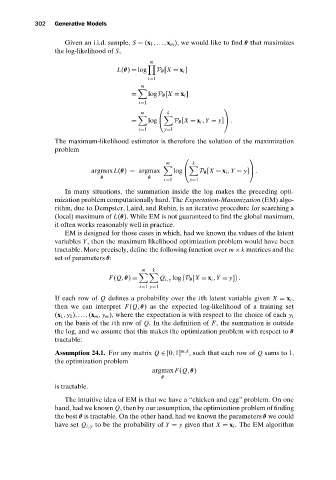Page 320 - Understanding Machine Learning
P. 320
Generative Models
302
Given an i.i.d. sample, S = (x 1 ,...,x m ), we would like to find θ that maximizes
the log-likelihood of S,
m
L(θ) = log P θ [X = x i ]
i=1
m
= logP θ [X = x i ]
i=1
m k
= log P θ [X = x i ,Y = y] .
i=1 y=1
The maximum-likelihood estimator is therefore the solution of the maximization
problem
m k
argmax L(θ) = argmax log P θ [X = x i ,Y = y] .
θ θ
i=1 y=1
In many situations, the summation inside the log makes the preceding opti-
mization problem computationally hard. The Expectation-Maximization (EM) algo-
rithm, due to Dempster, Laird, and Rubin, is an iterative procedure for searching a
(local) maximum of L(θ). While EM is not guaranteed to find the global maximum,
it often works reasonably well in practice.
EM is designed for those cases in which, had we known the values of the latent
variables Y, then the maximum likelihood optimization problem would have been
tractable. More precisely, define the following function over m × k matrices and the
set of parameters θ:
m k
F(Q,θ) = Q i,y log P θ [X = x i ,Y = y] .
i=1 y=1
If each row of Q defines a probability over the ith latent variable given X = x i ,
then we can interpret F(Q,θ) as the expected log-likelihood of a training set
(x 1 , y 1 ),...,(x m , y m ), where the expectation is with respect to the choice of each y i
on the basis of the ith row of Q. In the definition of F, the summation is outside
the log, and we assume that this makes the optimization problem with respect to θ
tractable:
Assumption 24.1. For any matrix Q ∈ [0,1] m,k , such that each row of Q sums to 1,
the optimization problem
argmax F(Q,θ)
θ
is tractable.
The intuitive idea of EM is that we have a “chicken and egg” problem. On one
hand, had we known Q, then by our assumption, the optimization problem of finding
the best θ is tractable. On the other hand, had we known the parameters θ we could
have set Q i,y to be the probability of Y = y given that X = x i . The EM algorithm

